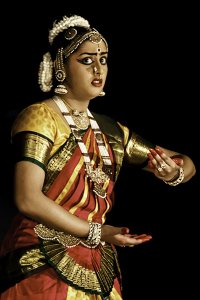
|   |

|   |
Noopuradhwani Dance Festival Text & pics: Hareesh N. Nampoothiri e-mail: newn.haree@gmail.com April 15, 2014 Kalamandalam Krishnan Nair was one of the greatest maestros in Kathakali and this year marks the centenary of his birth. A handful of organizations across the state celebrated this (while it seems that his alma mater and the cultural department of the state government are yet to make a move) by organizing events and one among them was Noopura, a dance institution formed in memory of Krishnan Nair. Noopuradhwani, the dance festival by the institute, organized in lieu of the centenary birth date of Krishnan Nair at Theerthapada Mandapam in Thiruvananthapuram, featured solo performances of Gopika Varma (Mohiniattam) on April 7, Manisha Gulyani (Kathak) and Renuka Sajiv (Bharatanatyam) on April 9.  Gopika Varma
The delayed start of the program forced Gopika Varma to trim her performance to two pieces apart from the introductory Ganapathy Sthuthi. ‘Satyabhama Garvabhangam’ was the main piece in which she presented stories of Parijata and Krishna Tulabhara. As the dancer concentrated mainly on the nrithya and natya part, nritha was barely seen in this piece. The piece also couldn't produce that kind of an excitement as it ended up nothing more than simple narration of the two stories. Moreover, Satyabhama was seen in the same shades as one would expect, though the dancer introduced the piece as an attempt to present the heroine in a different light. The dancer’s candid expressions, postures and moves were the elements that kept the audience engaged in spite of these shortfalls. Swathi Thirunal bhajan "Visweswar Darsan Kar..." (Sindhu Bhairavi / rupaka) was the final piece. Maybe she could have done it without those unnecessary elaborations. Detailing the process of birth and death for the line “janan-maran phamsi...” didn't seem apt, considering that the bhajan moves on a spiritual plane. The actions showing the flow of Ganga was also seen stretched more than what was required. While it is always good to give a short introduction prior to each item, adding too much of personal anecdotes and experiences, as Gopika did here, makes it rather pretentious. Energetic footwork twined with the signature chakkars, Manisha Gulyani ably brought alive the Jaipur style of Kathak. Starting with a Saraswati Vandana and then moving on to the technical pieces starting with an Aamad in teen taal, Manisha effortlessly brought those bols to life through her swift footwork and graceful movements. Be it the postures in thaats or the footwork ending on ‘sam’ in tihais or the continuous spins in between, the presentation was profound and the audience was kept engaged. The technical segment was followed by ‘Zehaal-E-Miskeen,’ one of Amir Khusro’s popular sufi poetry in which Manisha explored the emotive part. Often we get to see only excerpts of these compositions but thanks to the dancer for presenting it in full here. Credit goes to Pt. Udai Mazumdar, Manisha’s guru as well as the tabla player for the evening, for the wonderful support that he rendered all through the performance. Piu Nandi on vocal and Bhaskar Das on flute formed the rest of the team. Manisha also did a few tukdas, parans, tihais before concluding with a short jugalbandi.  Manisha Gulyani  Renuka Sajiv Renuka Sajiv is a young dancer based in Dubai and a disciple of Kottakal Sasi. For a dancer still in her teens, Renuka showed enough maturity than one would normally expect. She chose to open with the infrequent ‘Amma Kauthuvam’ (Karna Ranjani / adi / Madurai R Muralidharan), in praise of own mother, rather than the popular kauthuvams on Ganesha, Natesa or Kali. “Maye Manam...,” the Simhendramadhyamam varnam in praise of goddess Meenakshi set to adi tala, again a composition of Madurai R Muralidharan, was the central piece. Though she managed to sync her footwork and movements to recorded music during jathis and lyrical parts, she struggled to do so in narrative parts. However, she somewhat managed to outlive this with her enthusiastic stage presence and innate acting abilities. “Vishamakara Kannan...” (Chenchurutti / eka tala / Oothukkadu Venkatasubba Iyer) and “Anandanadanam Aduvathaen Mayile?” (Hamsanandi / adi / Tara Natarajan) were the items that followed and she was seen more comfortable presenting the joyful characters in these pieces. The concluding piece was a Meera bhajan in Darbari Kanada. Apart from these solo performances, the three-day festival also featured 'Kuchela Vrutham' Kathakali and a few group presentations by the students and alumni of the institute. Hareesh N Nampoothiri is a visual design consultant by profession and a lover of classical art forms. Being an ardent follower of Kathakali, he conceptualized and directed a documentary on Kathakali titled 'Thouryathrikam,' which introduces the nuances of Kathakali to the common man. Writing and photography are his other passions. |